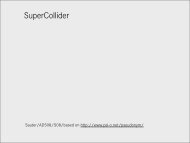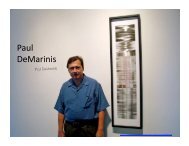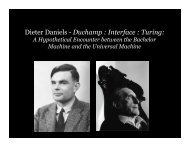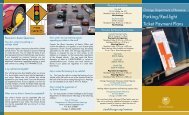the coming age of calm technology[1] - Daniel Sauter
the coming age of calm technology[1] - Daniel Sauter
the coming age of calm technology[1] - Daniel Sauter
- No tags were found...
You also want an ePaper? Increase the reach of your titles
YUMPU automatically turns print PDFs into web optimized ePapers that Google loves.
Bits flowing through <strong>the</strong> wires <strong>of</strong> a computer network are invisible...http://www.ubiq.com/hypertext/weiser/acmfuture2endnote.htmTHE COMING AGE OFCALM TECHNOLOGY[1]Mark Weiser and John Seely BrownXerox PARCOctober 5, 1996INTRODUCTIONThe important waves <strong>of</strong> technological change are those that fundamentally alter <strong>the</strong> place <strong>of</strong><strong>technology</strong> in our lives. What matters is not <strong>technology</strong> itself, but its relationship to us.In <strong>the</strong> past fifty years <strong>of</strong> computation <strong>the</strong>re have been two great trends in this relationship: <strong>the</strong>mainframe relationship, and <strong>the</strong> PC relationship. Today <strong>the</strong> Internet is carrying us through an era <strong>of</strong>widespread distributed computing towards <strong>the</strong> relationship <strong>of</strong> ubiquitous computing, characterizedby deeply imbedding computation in <strong>the</strong> world. Ubiquitous computing will require a new approachto fitting <strong>technology</strong> to our lives, an approach we call "<strong>calm</strong> <strong>technology</strong>".This article briefly describes <strong>the</strong> relationship trends, and <strong>the</strong>n expands on <strong>the</strong> challenges <strong>of</strong> designingfor <strong>calm</strong> using both <strong>the</strong> center and <strong>the</strong> periphery <strong>of</strong> our perception and <strong>the</strong> world.The Major Trends in ComputingMainframemany people share a computerPersonal Computerone computer, one personInternet - Widespread Distributed Computing . . . transition to . . .Ubiquitous Computingmany computers share each <strong>of</strong> usPHASE I - THE MAINFRAME ERAThe first era we call "mainframe", to recall <strong>the</strong> relationship people had with computers that weremostly run by experts behind closed doors. Anytime a computer is a scarce resource, and must benegotiated and shared with o<strong>the</strong>rs, our relationship is that <strong>of</strong> <strong>the</strong> mainframe era. There is mainframecomputing today: a shared <strong>of</strong>fice PC, and <strong>the</strong> great physical simulations <strong>of</strong> everything from wea<strong>the</strong>rto virtual reality, have in common sharing a scarce resource. If lots <strong>of</strong> people share a computer, it ismainframe computing.PHASE II - THE PC ERAThe second great trend is that <strong>of</strong> <strong>the</strong> personal computer. In 1984 <strong>the</strong> number <strong>of</strong> people usingpersonal computers surpassed <strong>the</strong> number <strong>of</strong> people using shared computers.[2] The personalcomputing relationship is personal, even intimate. You have your computer, it contains your stuff,and you interact directly and deeply with it. When doing personal computing you are occupied, youare not doing something else. Some people name <strong>the</strong>ir PC - many people curse or complain to <strong>the</strong>irPC.The personal computer is most analogous to <strong>the</strong> automobile - a special, relatively expensive item, thatwhile it may "take you where you want to go", requires considerable attention to operate. And just asone can own several cars, one can own several personal computers: for home, for work, and for <strong>the</strong>road. Any computer with which you have a special relationship, or that fully eng<strong>age</strong>s or occupies1 <strong>of</strong> 7 3/3/08 12:25 PM
Bits flowing through <strong>the</strong> wires <strong>of</strong> a computer network are invisible...http://www.ubiq.com/hypertext/weiser/acmfuture2endnote.htmyou when you use it, is a personal computer. Most handheld computers, such as <strong>the</strong> Zaurus, <strong>the</strong>Newton, or <strong>the</strong> Pilot, are today still used as personal computers. A $500 network computer is still apersonal computer.TRANSITION - THE INTERNET AND DISTRIBUTEDCOMPUTINGA lot has been written about <strong>the</strong> Internet and where it is leading. We will say only a little. TheInternet is deeply influencing <strong>the</strong> business and practice <strong>of</strong> <strong>technology</strong>. Millions <strong>of</strong> new people and<strong>the</strong>ir information have become interconnected. Late at night, around 6am while falling asleep aftertwenty hours at <strong>the</strong> keyboard, <strong>the</strong> sensitive technologist can sometimes hear those 35 million webp<strong>age</strong>s, 300 thousand hosts, and 90 million users shouting "pay attention to me!"Interestingly, <strong>the</strong> Internet brings toge<strong>the</strong>r elements <strong>of</strong> <strong>the</strong> mainframe era and <strong>the</strong> PC era. It isclient-server computing on a massive scale, with web clients <strong>the</strong> PCs and web servers <strong>the</strong>mainframes (without <strong>the</strong> MIS department in charge). Although transitional, <strong>the</strong> Internet is a massivephenomena that calls to our best inventors, our most innovative financiers, and our largestmultinational corporations. Over <strong>the</strong> next decade <strong>the</strong> results <strong>of</strong> <strong>the</strong> massive interconnection <strong>of</strong>personal, business, and government information will create a new field, a new medium, againstwhich <strong>the</strong> next great relationship will emerge.PHASE III - THE UC ERAThe third wave <strong>of</strong> computing is that <strong>of</strong> ubiquitous computing, whose cross-over point with personalcomputing will be around 2005-2020[3]. The "UC" era will have lots <strong>of</strong> computers sharing each <strong>of</strong>us. Some <strong>of</strong> <strong>the</strong>se computers will be <strong>the</strong> hundreds we may access in <strong>the</strong> course <strong>of</strong> a few minutes <strong>of</strong>Internet browsing. O<strong>the</strong>rs will be imbedded in walls, chairs, clothing, light switches, cars - ineverything. UC is fundamentally characterized by <strong>the</strong> connection <strong>of</strong> things in <strong>the</strong> world withcomputation. This will take place at a many scales, including <strong>the</strong> microscopic[4].There is much talk today about "thin clients," meaning lightweight Internet access devices costingonly a few hundred dollars. But UC will see <strong>the</strong> creation <strong>of</strong> thin servers, costing only tens <strong>of</strong> dollarsor less, that put a full Internet server into every household appliance and piece <strong>of</strong> <strong>of</strong>fice equipment.The next generation Internet protocol, IPv6[5], can address more than a thousand devices for everyatom on <strong>the</strong> earth's surface[6]. We will need <strong>the</strong>m all.The social impact <strong>of</strong> imbedded computers may be analogous to two o<strong>the</strong>r technologies that havebecome ubiquitous. The first is writing, which is found everywhere from clo<strong>the</strong>s labels to billboards.The second is electricity, which surges invisibly through <strong>the</strong> walls <strong>of</strong> every home, <strong>of</strong>fice, and car.Writing and electricity become so commonplace, so unremarkable, that we forget <strong>the</strong>ir huge impacton everyday life. So it will be with UC.Two harbingers <strong>of</strong> <strong>the</strong> <strong>coming</strong> UC era are found in <strong>the</strong> imbedded microprocessor, and <strong>the</strong> Internet. Itis easy to find 40 microprocessors in a middle class home in <strong>the</strong> U.S.A. today. They will be found in<strong>the</strong> alarm clocks, <strong>the</strong> microwave oven, <strong>the</strong> TV remote controls, <strong>the</strong> stereo and TV system, <strong>the</strong> kid'stoys, etc. These do not yet qualify as UC for two reasons: <strong>the</strong>y are mostly used one at a time, and<strong>the</strong>y are still masquerading as old-style devices like toasters and clocks. But network <strong>the</strong>m toge<strong>the</strong>rand <strong>the</strong>y are an enabling <strong>technology</strong> for UC. Tie <strong>the</strong>m to <strong>the</strong> Internet, and now you have connectedtoge<strong>the</strong>r millions <strong>of</strong> information sources with hundreds <strong>of</strong> information delivery systems in yourhouse. Clocks that find out <strong>the</strong> correct time after a power failure, microwave ovens that downloadnew recipes, kids toys that are ever refreshed with new s<strong>of</strong>tware and vocabularies, paint that cleans<strong>of</strong>f dust and notifies you <strong>of</strong> intruders, walls that selectively dampen sounds, are just a fewpossibilities.The UC will bring information <strong>technology</strong> beyond <strong>the</strong> big problems like corporate finance andschool homework, to <strong>the</strong> little annoyances like Where are <strong>the</strong> car-keys, Can I get a parking place, and2 <strong>of</strong> 7 3/3/08 12:25 PM
Bits flowing through <strong>the</strong> wires <strong>of</strong> a computer network are invisible...http://www.ubiq.com/hypertext/weiser/acmfuture2endnote.htmIs that shirt I saw last week at Macy's still on <strong>the</strong> rack? Many researchers are working towards thisnew era - among <strong>the</strong>m our work at Xerox PARC, MIT's AI-oriented "Things That Think"program[7], <strong>the</strong> many mobile and wearable computing programs[8] (many funded by ARPA), and<strong>the</strong> many companies integrating computation into everyday objects, including Mattel and Disney.What qualifies <strong>the</strong>se as fundamental trends? First, <strong>the</strong>y are about basic human relationships, and soare trends about what matters to us, what we cannot avoid. Second, <strong>the</strong>y have <strong>the</strong> property <strong>of</strong>building upon one ano<strong>the</strong>r. It is apparent that <strong>the</strong> mainframe relationship will never die completelyaway, nor <strong>the</strong> personal computing relationship. Each is used as a ground for <strong>the</strong> next trend,confirming its importance in its own mode <strong>of</strong> decline. Third, <strong>the</strong>y are each bountiful sources <strong>of</strong>innovation, and have required reopening old assumptions, and re-appropriating old <strong>technology</strong> intonew contexts.It has been said many times that PC operating systems are about twenty years behind mainframeoperating systems - but this statement misunderstands what happens in technological revolutions.The radically new context <strong>of</strong> <strong>the</strong> PC - uncontrolled room, uncontrolled third party s<strong>of</strong>tware,uncontrolled power, third party hardware components, retail sales, low-cost requirements, frequentupgrades - meant that mainframe technologies required considerable adaptation. The era <strong>of</strong>ubiquitous computing is already starting to see old assumptions questioned top to bottom incomputer systems design. For instance, our work on ubiquitous computers required us to introducenew progress metrics such as MIPS/Watt and Bits/Sec/M 3 . (After over a decade <strong>of</strong> stagnation,MIPS/Watt has improved over a hundred-fold in <strong>the</strong> past three years.) Research from radios to userinterface, from hardware to <strong>the</strong>ory, are impacted by <strong>the</strong> changed context <strong>of</strong> ubiquity.[9]The most potentially interesting, challenging, and pr<strong>of</strong>ound change implied by <strong>the</strong> ubiquitouscomputing era is a focus on <strong>calm</strong>. If computers are everywhere <strong>the</strong>y better stay out <strong>of</strong> <strong>the</strong> way, andthat means designing <strong>the</strong>m so that <strong>the</strong> people being shared by <strong>the</strong> computers remain serene and incontrol. Calmness is a new challenge that UC brings to computing. When computers are used behindclosed doors by experts, <strong>calm</strong>ness is relevant to only a few. Computers for personal use havefocused on <strong>the</strong> excitement <strong>of</strong> interaction. But when computers are all around, so that we want tocompute while doing something else and have more time to be more fully human, we must radicallyrethink <strong>the</strong> goals, context and <strong>technology</strong> <strong>of</strong> <strong>the</strong> computer and all <strong>the</strong> o<strong>the</strong>r <strong>technology</strong> crowding intoour lives. Calmness is a fundamental challenge for all technological design <strong>of</strong> <strong>the</strong> next fifty years.The rest <strong>of</strong> this paper opens a dialogue about <strong>the</strong> design <strong>of</strong> <strong>calm</strong> <strong>technology</strong>.CALM TECHNOLOGYDesigns that en<strong>calm</strong> and inform meet two human needs not usually met toge<strong>the</strong>r. Information<strong>technology</strong> is more <strong>of</strong>ten <strong>the</strong> enemy <strong>of</strong> <strong>calm</strong>. P<strong>age</strong>rs, cellphones, news-services, <strong>the</strong>World-Wide-Web, email, TV, and radio bombard us frenetically. Can we really look to <strong>technology</strong>itself for a solution?But some <strong>technology</strong> does lead to true <strong>calm</strong> and comfort. There is no less <strong>technology</strong> involved in acomfortable pair <strong>of</strong> shoes, in a fine writing pen, or in delivering <strong>the</strong> New York Times on a Sundaymorning, than in a home PC. Why is one <strong>of</strong>ten enraging, <strong>the</strong> o<strong>the</strong>rs frequently en<strong>calm</strong>ing? Webelieve <strong>the</strong> difference is in how <strong>the</strong>y eng<strong>age</strong> our attention. Calm <strong>technology</strong> eng<strong>age</strong>s both <strong>the</strong> centerand <strong>the</strong> periphery <strong>of</strong> our attention, and in fact moves back and forth between <strong>the</strong> two.THE PERIPHERYWe use "periphery" to name what we are attuned to without attending to explicitly.[10] Ordinarilywhen driving our attention is centered on <strong>the</strong> road, <strong>the</strong> radio, our passenger, but not <strong>the</strong> noise <strong>of</strong> <strong>the</strong>engine. But an unusual noise is noticed immediately, showing that we were attuned to <strong>the</strong> noise in<strong>the</strong> periphery, and could come quickly to attend to it.3 <strong>of</strong> 7 3/3/08 12:25 PM
Bits flowing through <strong>the</strong> wires <strong>of</strong> a computer network are invisible...http://www.ubiq.com/hypertext/weiser/acmfuture2endnote.htmIt should be clear that what we mean by <strong>the</strong> periphery is anything but on <strong>the</strong> fringe or unimportant.What is in <strong>the</strong> periphery at one moment may in <strong>the</strong> next moment come to be at <strong>the</strong> center <strong>of</strong> ourattention and so be crucial. The same physical form may even have elements in both <strong>the</strong> center andperiphery. The ink that communicates <strong>the</strong> central words <strong>of</strong> a text also peripherally clues us into <strong>the</strong>genre <strong>of</strong> <strong>the</strong> text though choice <strong>of</strong> font and layout.A <strong>calm</strong> <strong>technology</strong> will move easily from <strong>the</strong> periphery <strong>of</strong> our attention, to <strong>the</strong> center, and back. Thisis fundamentally en<strong>calm</strong>ing, for two reasons.First, by placing things in <strong>the</strong> periphery we are able to attune to many more things than we could ifeverything had to be at <strong>the</strong> center. Things in <strong>the</strong> periphery are attuned to by <strong>the</strong> large portion <strong>of</strong> ourbrains devoted to peripheral (sensory) processing. Thus <strong>the</strong> periphery is informing withoutoverburdening.Second, by recentering something formerly in <strong>the</strong> periphery we take control <strong>of</strong> it. Peripherally wemay become aware that something is not quite right, as when awkward sentences leave a reader tiredand discomforted without knowing why. By moving sentence construction from periphery to centerwe are empowered to act, ei<strong>the</strong>r by finding better literature or accepting <strong>the</strong> source <strong>of</strong> <strong>the</strong> unease andcontinuing. Without centering <strong>the</strong> periphery might be a source <strong>of</strong> frantic following <strong>of</strong> fashion; withcentering <strong>the</strong> periphery is a fundamental enabler <strong>of</strong> <strong>calm</strong> through increased awareness and power.Not all <strong>technology</strong> need be <strong>calm</strong>. A <strong>calm</strong> videogame would get little use; <strong>the</strong> point is to be excited.But too much design focuses on <strong>the</strong> object itself and its surface features without regard for context.We must learn to design for <strong>the</strong> periphery so that we can most fully command <strong>technology</strong> withoutbeing dominated by it.Our notion <strong>of</strong> <strong>technology</strong> in <strong>the</strong> periphery is related to <strong>the</strong> notion <strong>of</strong> affordances, due to Gibson[11]and applied to <strong>technology</strong> by Gaver[12] and Norman[13]. An affordance is a relationship betweenan object in <strong>the</strong> world and <strong>the</strong> intentions, perceptions, and capabilities <strong>of</strong> a person. The side <strong>of</strong> a doorthat only pushes out affords this action by <strong>of</strong>fering a flat pushplate. The idea <strong>of</strong> affordance, powerfulas it is, tends to describe <strong>the</strong> surface <strong>of</strong> a design. For us <strong>the</strong> term "affordance" does not reach farenough into <strong>the</strong> periphery where a design must be attuned to but not attended to.THREE SIGNS OF CALM TECHNOLOGYTechnologies en<strong>calm</strong> as <strong>the</strong>y empower our periphery. This happens in two ways. First, as alreadymentioned, a <strong>calm</strong>ing <strong>technology</strong> may be one that easily moves from center to periphery and back.Second, a <strong>technology</strong> may enhance our peripheral reach by bringing more details into <strong>the</strong> periphery.An example is a video conference that, by comparison to a telephone conference, enables us to attuneto nuances <strong>of</strong> body posture and facialexpression that would o<strong>the</strong>rwise be inaccessible. This is en<strong>calm</strong>ing when <strong>the</strong> enhanced peripheralreach increases our knowledge and so our ability to act without increasing information overload.The result <strong>of</strong> <strong>calm</strong> <strong>technology</strong> is to put us at home, in a familiar place. When our periphery isfunctioning well we are tuned into what is happening around us, and so also to what is going tohappen, and what has just happened. This is a key property <strong>of</strong> information visualization techniqueslike <strong>the</strong> cone tree,[14] that are filled with detail yet eng<strong>age</strong> our pre-attentive periphery so we arenever surprised. The periphery connects us effortlessly to a myriad <strong>of</strong> familiar details. Thisconnection to <strong>the</strong> world we called "locatedness", and it is <strong>the</strong> fundamental gift that <strong>the</strong> peripherygives us.EXAMPLES OF CALM TECHNOLOGYWe now consider a few designs in terms <strong>of</strong> <strong>the</strong>ir motion between center and periphery, peripheralreach, and locatedness. Below we consider inner <strong>of</strong>fice windows, Internet Multicast, and <strong>the</strong>Dangling String.4 <strong>of</strong> 7 3/3/08 12:25 PM
Bits flowing through <strong>the</strong> wires <strong>of</strong> a computer network are invisible...http://www.ubiq.com/hypertext/weiser/acmfuture2endnote.htmINNER OFFICE WINDOWSWe do not know who invented <strong>the</strong> concept <strong>of</strong> glass windows from <strong>of</strong>fices out to hallways. But <strong>the</strong>seinner windows are a beautifully simple design that enhances peripheral reach and locatedness.The hallway window extends our periphery by creating a two-way channel for clues about <strong>the</strong>environment. Whe<strong>the</strong>r it is motion <strong>of</strong> o<strong>the</strong>r people down <strong>the</strong> hall (its time for a lunch; <strong>the</strong> big meetingis starting), or noticing <strong>the</strong> same person peeking in for <strong>the</strong> third time while you are on <strong>the</strong> phone(<strong>the</strong>y really want to see me; I forgot an appointment), <strong>the</strong> window connects <strong>the</strong> person inside to <strong>the</strong>nearby world.Inner windows also connect with those who are outside <strong>the</strong> <strong>of</strong>fice. A light shining out into <strong>the</strong> hallmeans someone is working late; someone picking up <strong>the</strong>ir <strong>of</strong>fice means this might be a good time fora casual chat. These small clues become part <strong>of</strong> <strong>the</strong> periphery <strong>of</strong> a <strong>calm</strong> and comfortable workplace.Office windows illustrate a fundamental property <strong>of</strong> motion between center and periphery. Contrast<strong>the</strong>m with an open <strong>of</strong>fice plan in which desks are separated only by low or no partitions. Open<strong>of</strong>fices force too much to <strong>the</strong> center. For example, a person hanging out near an open cubicledemands attention by social conventions <strong>of</strong> privacy and politeness.There is less opportunity for <strong>the</strong> subtle clue <strong>of</strong> peeking through a window without eavesdropping ona conversation. The individual, not <strong>the</strong> environment, must be in charge <strong>of</strong> moving things from centerto periphery and back.The inner <strong>of</strong>fice window is a metaphor for what is most exciting about <strong>the</strong> Internet, namely <strong>the</strong>ability to locate and be located by people passing by on <strong>the</strong> information highway, while retainingpartial control <strong>of</strong> <strong>the</strong> context, timing, and use <strong>of</strong> <strong>the</strong> information <strong>the</strong>reby obtained.INTERNET MULTICASTA <strong>technology</strong> called Internet Multicast[15] may become <strong>the</strong> next World Wide Web (WWW)phenomenon. Sometimes called <strong>the</strong> MBone (for Multicast backBONE), multicasting was inventedby a <strong>the</strong>n graduate student at Stanford University, Steve Deering.Whereas <strong>the</strong> World Wide Web (WWW) connects only two computers at a time, and <strong>the</strong>n only for <strong>the</strong>few moments that information is being downloaded, <strong>the</strong> MBone continuously connects manycomputers at <strong>the</strong> same time. To use <strong>the</strong> familiar highway metaphor, for any one person <strong>the</strong> WWWonly lets one car on <strong>the</strong> road at a time, and it must travel straight to its destination with no stops orside trips. By contrast, <strong>the</strong> MBone opens up streams <strong>of</strong> traffic between multiple people and soenables <strong>the</strong> flow <strong>of</strong> activities that constitute a neighborhood. Where a WWW browser venturestimidly to one location at a time before scurrying back home again a few milliseconds later, <strong>the</strong>MBone sustains ongoing relationships between machines, places, and people.Multicast is fundamentally about increasing peripheral reach, derived from its ability to cheaplysupport multiple multimedia (video, audio, etc.) connections all day long. Continuous video from5 <strong>of</strong> 7 3/3/08 12:25 PM
Bits flowing through <strong>the</strong> wires <strong>of</strong> a computer network are invisible...http://www.ubiq.com/hypertext/weiser/acmfuture2endnote.htmano<strong>the</strong>r place is no longer television, and no longer video-conferencing, but more like a window <strong>of</strong>awareness. A continuous video stream brings new details into <strong>the</strong> periphery: <strong>the</strong> room is cleaned up,something important may be about to happen; everyone got in late today on <strong>the</strong> east coast, must be abig snowstorm or traffic tie-up.Multicast shares with videoconferencing and television an increased opportunity to attune toadditional details. Compared to a telephone or fax, <strong>the</strong> broader channel <strong>of</strong> full multimedia betterprojects <strong>the</strong> person through <strong>the</strong> wire. The presence is enhanced by <strong>the</strong> responsiveness that fulltwo-way (or multiway) interaction brings.Like <strong>the</strong> inner windows, Multicast enables control <strong>of</strong> <strong>the</strong> periphery to remain with <strong>the</strong> individual, not<strong>the</strong> environment. A properly designed real-time Multicast tool will <strong>of</strong>fer, but not demand. TheMBone provides <strong>the</strong> necessary partial separation for moving between center and periphery that ahigh bandwidth world alone does not. Less is more, when less bandwidth provides more <strong>calm</strong>ness.Multicast at <strong>the</strong> moment is not an easy <strong>technology</strong> to use, and only a few applications have beendeveloped by some very smart people. This could also be said <strong>of</strong> <strong>the</strong> digital computer in 1945, and<strong>of</strong> <strong>the</strong> Internet in 1975. Multicast in our periphery will utterly change our world over <strong>the</strong> next fiftyyears.DANGLING STRINGBits flowing through <strong>the</strong> wires <strong>of</strong> a computer network are ordinarily invisible. But a radically newtool shows those bits through motion, sound, and even touch. It communicates both light and heavynetwork traffic. Its output is so beautifully integrated with human information processing that onedoes not even need to be looking at it or be very near to it to take advant<strong>age</strong> <strong>of</strong> its peripheral clues. Ittakes no space on your existing computer screen, and in fact does not use or contain a computer atall. It uses no s<strong>of</strong>tware, only a few dollars in hardware, and can be shared by many people at <strong>the</strong>same time. It is called <strong>the</strong> "Dangling String".Created by artist Natalie Jeremijenko, <strong>the</strong> "Dangling String" is an 8 foot piece <strong>of</strong> plastic spaghettithat hangs from a small electric motor mounted in <strong>the</strong> ceiling. The motor is electrically connected to anearby E<strong>the</strong>rnet cable, so that each bit <strong>of</strong> information that goes past causes a tiny twitch <strong>of</strong> <strong>the</strong> motor.A very busy network causes a madly whirling string with a characteristic noise; a quiet networkcauses only a small twitch every few seconds. Placed in an unused corner <strong>of</strong> a hallway, <strong>the</strong> longstring is visible and audible from many <strong>of</strong>fices without being obtrusive. It is fun and useful. At firstit creates a new center <strong>of</strong> attention just by being unique. But this center soon becomes peripheral as<strong>the</strong> gentle waving <strong>of</strong> <strong>the</strong> string moves easily to <strong>the</strong> background. That <strong>the</strong> string can be both seen andheard helps by increasing <strong>the</strong> clues for peripheral attunement.The dangling string increases our peripheral reach to <strong>the</strong> formerly inaccessible network traffic. Whilescreen displays <strong>of</strong> traffic are common, <strong>the</strong>ir symbols require interpretation and attention, and do notperipheralize well. The string, in part because it is actually in <strong>the</strong> physical world, has a betterimpedance match with our brain's peripheral nerve centers.6 <strong>of</strong> 7 3/3/08 12:25 PM
Bits flowing through <strong>the</strong> wires <strong>of</strong> a computer network are invisible...http://www.ubiq.com/hypertext/weiser/acmfuture2endnote.htmIN CONCLUSIONIt seems contradictory to say, in <strong>the</strong> face <strong>of</strong> frequent complaints about information overload, thatmore information could be en<strong>calm</strong>ing. It seems almost nonsensical to say that <strong>the</strong> way to becomeattuned to more information is to attend to it less. It is <strong>the</strong>se apparently bizarre features that mayaccount for why so few designs properly take into account center and periphery to achieve anincreased sense <strong>of</strong> locatedness. But such designs are crucial as we move into <strong>the</strong> era <strong>of</strong> ubiquitouscomputing. As we learn to design <strong>calm</strong> <strong>technology</strong>, we will enrich not only our space <strong>of</strong> artifacts,but also our opportunities for being with o<strong>the</strong>r people. When our world is filled with interconnected,imbedded computers, <strong>calm</strong> <strong>technology</strong> will play a central role in a more humanly empoweredtwenty-first century.REFERENCES[1] This paper is a revised version <strong>of</strong>: Weiser & Brown. "Designing Calm Technology", PowerGridJournal, v 1.01, http://powergrid.electriciti.com/1.01 (July 1996).[2] IDC. "Transition to <strong>the</strong> Information Highway Era" in 1995-96 Information Industry andTechnology Update.p. 2.[3] IDC. Ibid.[4] Gabriel, K. "Engineering Microscopic Machines." Scientific American, Sept. 1995, Vol. 273,No. 3, pp. 118-121.[5] Deering, S. Hinden, R. "IPv6 Specification" http://ds.internic.net/rfc/rfc1883.txt, December 1995[6] Bolt, S. http://www2.wvitcoe.wvnet.edu/~sbolt/ip-density.html[7] MIT Media Lab. "Things That Think." http://ttt.www.media.mit.edu/[8] Watson, Terri. "Mobile and Wireless Computing."http://snapple.cs.washington.edu:600/mobile/mobile_www.html[9] Weiser, M. "Some Computer Science Problems in Ubiquitous Computing," Communications <strong>of</strong><strong>the</strong> ACM, July 1993.[10] Brown, J.S. and Duguid, P. Keeping It Simple: Investigating Resources in <strong>the</strong> PeripherySolving <strong>the</strong> S<strong>of</strong>tware Puzzle. Ed. T. Winograd, Stanford University.[11] Gibson, J. The Ecological Approach to Visual Perception. New York: Houghton Mifflin, 1979.[12] Gaver, W.W. "Auditory Icons: Using Sound in Computer Interfaces" J. Human-ComputerInteraction. v2n2. 1986. pp. 167-177[13] Norman, D.A.. The Psychology <strong>of</strong> Everyday Things. New York: Basic Books, 1988.[14] Robertson, G.G. MacKinlay, J.D. and Card, S.K. "Cone trees: Animated 3D visualizations <strong>of</strong>hierarchical information." In HCI 91, p<strong>age</strong>s 189-194, 1991.[15] Kumar, Vinay, "MBone: Interactive Multimedia On The Internet", Macmillan Publishing,November 19957 <strong>of</strong> 7 3/3/08 12:25 PM


![the coming age of calm technology[1] - Daniel Sauter](https://img.yumpu.com/47923551/1/500x640/the-coming-age-of-calm-technology1-daniel-sauter.jpg)







